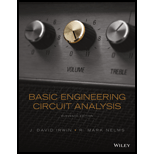
Basic Engineering Circuit Analysis
11th Edition
ISBN: 9781118539293
Author: J. David Irwin, R. Mark Nelms
Publisher: WILEY
expand_more
expand_more
format_list_bulleted
Question
error_outline
This textbook solution is under construction.
Students have asked these similar questions
3. Find the differential Equation model for the following electrical circuit. Write the
transfer function also. Here, input u(t) is a current source and output y(t) is the
current through the resistor R.
u(t) (I)
州
BR
NO AI PLEASE
NO AI PLEASE
Knowledge Booster
Learn more about
Need a deep-dive on the concept behind this application? Look no further. Learn more about this topic, electrical-engineering and related others by exploring similar questions and additional content below.Similar questions
- NO AI PLEASEarrow_forwardA professor teaches two sections of a course: • 70% of students are in Section 1, and 30% are in Section 2. • In Section 1, 90% of students pass the final exam. • In Section 2, 80% of students pass the final exam. A student is randomly selected. a) Draw a tree diagram to represent this situation. b) What is the probability that the selected student passes the exam? c) Given that a student failed, what is the probability they were from Section 1?arrow_forward.. A factory has two machines, A and B. Machine A produces 60% of the parts, while Machine B produces 40%. Machine A produces defective parts 5% of the time, while Machine B produces defective parts 10% of the time. A randomly selected part from production is inspected. a) Draw a tree diagram to represent the probability of getting a defective part. b) What is the probability that a randomly selected part is defective? c) If a part is found to be defective, what is the probability it came from Machine A?arrow_forward
- A Factory produces light bulbs from two different machines: Machine A and Machine B. The probability that a randomly selected light bulbs is from Machine A is 60%, and the probability that a light bulb is defective is 5%. Suppose that probability that a light bulb is defective given that it was made by Machine A is 0.05. Similarly, the probability that a light bulb is defective given that it was made by Machine B is 0.03. Are the events “the light bulb is from Machine A” and “the light bulb is defective” independent?arrow_forward3 (10pts). A Factory produces light bulbs from two different machines: Machine A and Machine B. The probability that a randomly selected light bulbs is from Machine A is 60%, and the probability that a light bulb is defective is 5%. Suppose that probability that a light bulb is defective given that it was made by Machine A is 0.05. Similarly, the probability that a light bulb is defective given that it was made by Machine B is 0.03. Are the events "the light bulb is from Machine A" and "the light bulb is defective" independent?arrow_forwardPlease see the followinggn imagearrow_forward
arrow_back_ios
SEE MORE QUESTIONS
arrow_forward_ios
Recommended textbooks for you
 Introductory Circuit Analysis (13th Edition)Electrical EngineeringISBN:9780133923605Author:Robert L. BoylestadPublisher:PEARSON
Introductory Circuit Analysis (13th Edition)Electrical EngineeringISBN:9780133923605Author:Robert L. BoylestadPublisher:PEARSON Delmar's Standard Textbook Of ElectricityElectrical EngineeringISBN:9781337900348Author:Stephen L. HermanPublisher:Cengage Learning
Delmar's Standard Textbook Of ElectricityElectrical EngineeringISBN:9781337900348Author:Stephen L. HermanPublisher:Cengage Learning Programmable Logic ControllersElectrical EngineeringISBN:9780073373843Author:Frank D. PetruzellaPublisher:McGraw-Hill Education
Programmable Logic ControllersElectrical EngineeringISBN:9780073373843Author:Frank D. PetruzellaPublisher:McGraw-Hill Education Fundamentals of Electric CircuitsElectrical EngineeringISBN:9780078028229Author:Charles K Alexander, Matthew SadikuPublisher:McGraw-Hill Education
Fundamentals of Electric CircuitsElectrical EngineeringISBN:9780078028229Author:Charles K Alexander, Matthew SadikuPublisher:McGraw-Hill Education Electric Circuits. (11th Edition)Electrical EngineeringISBN:9780134746968Author:James W. Nilsson, Susan RiedelPublisher:PEARSON
Electric Circuits. (11th Edition)Electrical EngineeringISBN:9780134746968Author:James W. Nilsson, Susan RiedelPublisher:PEARSON Engineering ElectromagneticsElectrical EngineeringISBN:9780078028151Author:Hayt, William H. (william Hart), Jr, BUCK, John A.Publisher:Mcgraw-hill Education,
Engineering ElectromagneticsElectrical EngineeringISBN:9780078028151Author:Hayt, William H. (william Hart), Jr, BUCK, John A.Publisher:Mcgraw-hill Education,

Introductory Circuit Analysis (13th Edition)
Electrical Engineering
ISBN:9780133923605
Author:Robert L. Boylestad
Publisher:PEARSON

Delmar's Standard Textbook Of Electricity
Electrical Engineering
ISBN:9781337900348
Author:Stephen L. Herman
Publisher:Cengage Learning

Programmable Logic Controllers
Electrical Engineering
ISBN:9780073373843
Author:Frank D. Petruzella
Publisher:McGraw-Hill Education

Fundamentals of Electric Circuits
Electrical Engineering
ISBN:9780078028229
Author:Charles K Alexander, Matthew Sadiku
Publisher:McGraw-Hill Education

Electric Circuits. (11th Edition)
Electrical Engineering
ISBN:9780134746968
Author:James W. Nilsson, Susan Riedel
Publisher:PEARSON

Engineering Electromagnetics
Electrical Engineering
ISBN:9780078028151
Author:Hayt, William H. (william Hart), Jr, BUCK, John A.
Publisher:Mcgraw-hill Education,
Inductors Explained - The basics how inductors work working principle; Author: The Engineering Mindset;https://www.youtube.com/watch?v=KSylo01n5FY;License: Standard Youtube License